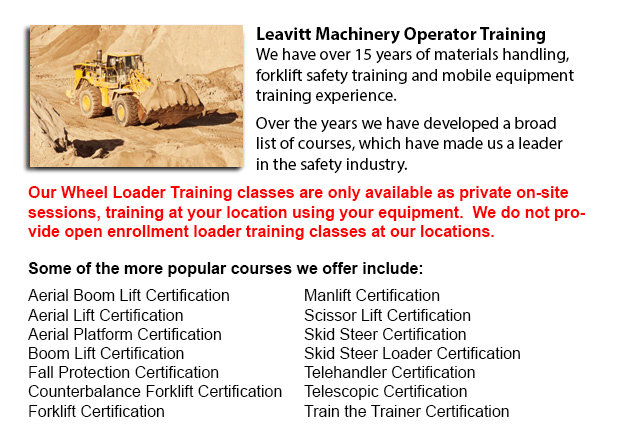
Wheel Loader Operator Training Kamloops - To be able to lift significant loads, industrial cranes make use of levers and pulleys. In the past, Roman people utilized cranes to construct big monuments making the origin of these machines at least 2,000 years ago. Several Medieval churches used cranes in their building and the Egyptians might have used them when constructing the pyramids.
The new version of a crane could be either complex or simple, and cranes vary based on their function. Mobile cranes, for example are rather simple. A steel truss or telescopic boom mounts its movable platform. A system of pulleys or levers raises the boom and there is normally a hook suspended. These cranes are frequently intended for demolition or earthmoving by changing the hook out with another piece of gadget such as a bucket or wrecking ball. Telescopic cranes have a series of hydraulic tubes that fit together to form the boom. These models can likewise be mobile.
Traditional wheels, or particular wheels utilized for a railroad track or caterpillar track allow these mobile booms to navigate uneven and unpaved surfaces.
Truck mounted and rough terrain cranes are even mobile with outriggers placed on the truck mounted unit increase stability. Nevertheless, rough terrain cranes consist of a base which tends to resemble the bottom of a 4-wheel drive. These cranes are equipped to be able to work on rough ground making them perfect in the construction trade for instance.
Gantry cranes are utilized to move and unload large containers off of ships and trains. They are most often seen working in railroads and ports. Their bases have massive crossbeams that run on rails so as to raise containers from a place to another. A portainer is a unique type of gantry that transports materials onto and off of ships specifically.
Floating cranes are connected on pontoons or barges and are another essential piece of machinery vital to the shipping business. For the reason that they are situated in water, they are utilized for a variety of services including port construction, building bridges and salvaging ships. Floating cranes can handle very heavy loads and containers and similar to portainers, they can likewise unload ships.
Loader cranes are fit onto trailers together with hydraulic powered booms in order to load merchandise onto a trailer. When not in use, the jointed parts of the boom could be folded down. This particular type of crane can be even considered telescopic in view of the fact that one section of the boom may telescope for more versatility.
Stacker cranes are normally utilized in automated warehouses. They tend to follow an automated retrieval system and can work by remote. These cranes are outfitted along with a lift truck machinery and could be seen in large automated freezers, obtaining or stacking food. Utilizing this type of system allows personnel to remain out of that cold setting.
Tower cranes are frequently the tallest cranes and normally do not have a movable base. They must be put together piece by piece. Their base resembles a long ladder along with the boom at a 90 degree angle to the base. These cranes specialize in the construction of tall structures and are usually affixed to the inside of the building itself through the construction period.
-
Forklift Training Course Kamloops
Forklift Training Course Kamloops - CSA and OSHA establish criteria for forklift safety training that meets current standards and regulations. Anybody planning to use a forklift is needed to successfully complete safety training prior to utilizing an... More -
Forklift Training Program Kamloops
Forklift Training Program Kamloops - The forklift is a common powered industrial vehicle which is in wide use these days. They are occasionally called lift trucks, jitneys or hi los. A departments store will use the forklift in order to unload and lo... More -
Aerial Lift Training Kamloops
Aerial Lift Training Kamloops - The mechanized access platform known as an aerial work platform is a machinery which provides access to places that are otherwise inaccessible to people and other machine. Likewise called an elevating work platform or... More -
Forklift Training School Kamloops
Forklift Training School Kamloops - Forklift Training School - CSA and OSHA establish criteria for forklift safety training which meets existing standards and regulations. Anybody planning to use a forklift is needed to successfully complete safety t... More -
Heavy Equipment Training Courses Kamloops
Heavy Equipment Training Courses Kamloops - When choosing a heavy equipment operator course, the initial step must be to determine the capacity in which you would be working with heavy machines. You could find the correct course to teach you how to o... More -
Heavy Equipment Training School Kamloops
Heavy Equipment Training School Kamloops - HEO or also known as the heavy equipment operator courses would provide you with the skills and knowledge required in order to enter the workforce as an entry level heavy machine operator. In this 12 week co... More -
Telehandler Operator Training Kamloops
Telehandler Operator Training Kamloops - Telescopic handler Forklifts or telehandler forklifts are common industrial equipment found in numerous construction industry environment. The telehandler is a helpful machinery and makes for a valuable tool w... More -
Telehandler License Kamloops
Telehandler License Kamloops - A telehandler or telescopic handler is a machine which is frequently utilized in agricultural and industrial applications. It has a similar appearance to a forklift and even works in a similar manner, though, the teleha... More

Forklift Training Kamloops
TOLL FREE: 1-888-254-6157
Kamloops, British Columbia
forklifttrainingkamloops.com
Email Us
About Us


